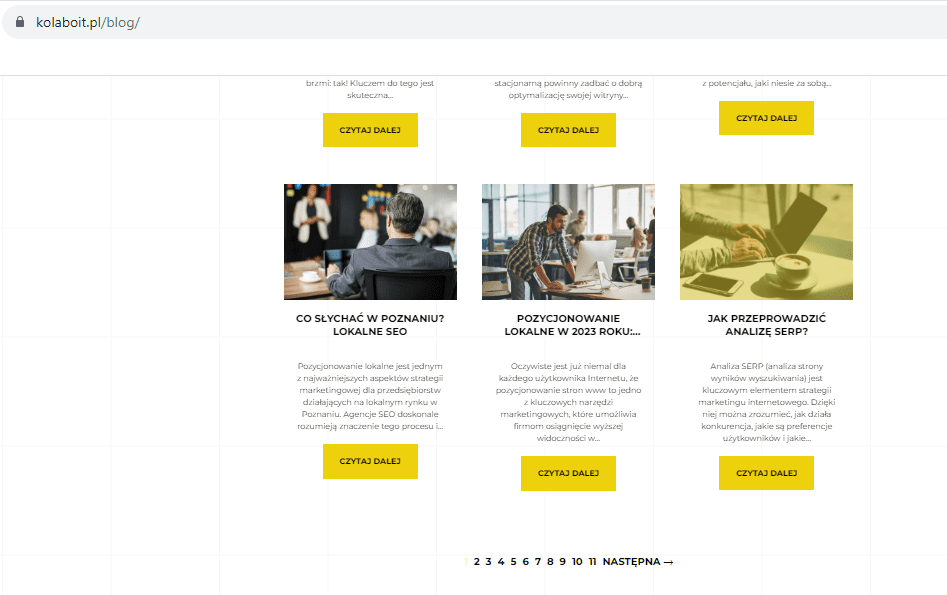Access to vast amounts of information is the norm. Blogs, websites and online stores offer a wide range of content, from articles to products. However, with this richness comes the question: how do you effectively deliver this content to users without overwhelming them with long pages or slow loading times? The answer is pagination – a key strategy for organizing and presenting content in a way that is attractive to both readers and search engines. In this article, we’ll explore the secrets of effective pagination, which can significantly improve your website’s usability and visibility in search results. Get ready to discover best practices and tips for creating pagination.

Do you want to increase your profits with SEO?
I will prepare an action strategy and, together with my team, implement it for you.
What is pagination on a website? Definition of
Pagination on a website is the process of breaking down more content, such as a list of articles, products, comments or search results, into smaller, more organized sections called “pages.” The purpose of pagination is to allow users to conveniently browse through a large amount of data by displaying only a certain number of items on a single page and allowing them to navigate between different pages.
Instead of presenting all the data on one long page, pagination allows users to more easily navigate through a set of content. Each page can contain, for example, 10, 20 or any other number of items, and users can move between pages using “Previous” and “Next” buttons or numbered links that allow them to jump to a specific page.
An example would be a list of articles on a blog, where each page displays a certain number of articles, and users can browse to the next page to see the rest of the content. Pagination is an important user interface element that improves readability, facilitates navigation, and helps to effectively manage large amounts of content on websites.
Example of pagination of content on a website
Here is an example of pagination of content on a website:
Suppose you have a website with a list of articles about travel, and you want to implement pagination so that users can conveniently browse multiple articles. Let’s also assume that you want to display 5 articles per page.
At the top of the page is a header with the title and description of the page, and below it is a list of articles.
Latest Travel Articles
1. article on Paris
2. guide to Rome
3. the beauty of New Zealand’s landscapes
4 Exploring the Mysteries of Japan
5th Expedition Beyond the North Pole
[1] [2] [3] [4] [5] > Next
In this example:
- 5 articles per page are displayed.
- Users can see the first five articles.
- At the end of the list are page numbers and a “Next” link.
- Users can click a page number to go to a specific page.
- When the user clicks “Next,” he or she will go to the next page with the next set of articles.
Pagination allows users to conveniently browse all articles, as well as facilitates navigation and avoids presenting too much content on one page.

What is the importance of pagination – for users and for SEO?
It has important implications for both users and search engine optimization (SEO). Here’s the significance:
For users:
- Better navigation: pagination improves the user experience by allowing a large amount of content to be viewed conveniently. Users do not have to scroll through long pages and can easily navigate between pages.
- Loading speed: With pagination, pages load faster because less content is displayed at once. This contributes to faster page loading and better UX .
- Avoiding confusion: A long page can be overwhelming and confusing for users. Pagination helps keep things organized and allows you to focus on specific parts of the content.
For SEO (search engine optimization):
- Better indexing: Search engines like Google index websites, and pagination can help index content effectively. If you have many articles, pagination allows search engines to index each page individually, increasing the visibility of the content.
- Managing duplicate content: Without pagination, a site may display the same content on different pages, which can lead to problems with duplicate content. Pagination helps avoid such problems because each page has a different set of content.
- Improving readability: For search engines and users, it is important that pages are readable and scannable. Pagination helps maintain clarity and makes it easier for both users and search engines to find content of interest.
- Page speed optimization: Search engines take page loading speed into account when evaluating the quality of a page. Pagination can positively affect loading speed, which is beneficial for SEO.
In short, pagination is an essential element for improving user experience and for optimizing a site for search engines. Proper implementation of pagination can result in higher site performance, better search engine results and user satisfaction.
Summary
In summary, effective pagination is the key to providing users with easy access to a large amount of content without overloading their interface. Properly designed pagination not only facilitates navigation and improves user experience, but also benefits search engine optimization.
Remember that every aspect of pagination – from the number of displayed elements on a page to the choice of appropriate navigation links – affects the user experience and the way your site is seen on the web.











